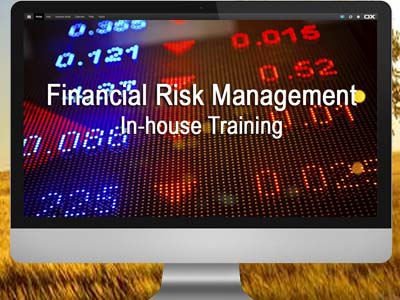The Financial Risk Management Course is very suitable for those who wish to gain a thorough understanding of Financial Risk Management and to prepare FRM exam preparation. Through this training, participants are expected to gain a deeper knowledge of the quantitative analysis, the latest modeling used for the calculation of market risk, credit risk and operational risk as well as the Risk Management and Investment Management equipped with practical examples to facilitate understanding. This program can be conducted in your office with approximately 45 hours or according to the needs of your company. In addition to getting the presentation materials of training, participants also get the software Excel-based Monte Carlo Simulation and various other spread sheets. Therefore, each participant is expected to bring a notebook on their own.
The agenda includes the following topics:
Quantitative Analysis: Probability & Statistics basic probability, random variables, probability distributions, mathematical expectation, special probability distributions, estimating parameters of distributions, mean, standard deviation, correlation, skewness, and kurtosis, sampling theory, estimation theory, tests of hypotheses and significance, curve fitting, regression, correlation, estimating volatilities and correlations, exponentially weighted moving average, GARCH, parameter estimation by maximum likelihood, Extreme Value Theory, Monte Carlo analysis
Quantitative Analysis: Financial Instruments time value of money, logarithms & exponents, mechanics of futures markets, determination of forward and futures prices, hedging strategies using futures, interest rate markets, swaps, mechanics of options markets, properties of stock options, trading strategies involving options, introduction to binomial trees, model of the behavior of stock prices, Black-Scholes model, the Greek letters, volatility smiles, exotic options
Quantitative Analysis: Fixed Income Securities bond features, types of bonds, bond prices, bond price volatility, discount factors, arbitrage, spot rates, forward rates, yield to maturity, curve fitting, one-factor measures of price sensitivity, measures of price sensitivity based on parallel yield shifts, duration and convexity, key rate and bucket exposures, the science of term structure models, fixed-income derivatives, Mortgage-Backed Securities, equity derivatives
Market Risk Measurement and Management market risk, fixed income risk, exchange rate risk, equity risk, commodity risk, emerging market risk, computing Value-at-Risk, VaR Methods, implementing Delta-Normal VaR, simulation methods, liquidity risk, liquidity gap, cash flow-at-risk, identifying and managing cash flow exposures, risk budgeting, stress testing, decomposing risk, aggregating and decomposing the risks of large portfolios, limitations and alternative risk measures, conditional Value-at-Risk, Extreme Value Theory in VaR, normal mixtures, marginal & incremental VaR, gaming the VaR, coherent risk measures, managing corporate exposures, hedging linear & non-linear risk, demand and supply for derivative products
Credit Risk Measurement and Management rating agencies, classic credit analysis, corporate credit risk models based on stock price, default rates, credit losses, recovery rates, credit risk migration, transition matrices, credit spreads, individual loan risk, loan portfolio and concentration risk, credit portfolio approaches, actuarial approach and CreditRisk+, contingent claim approach and the KMV model, CreditMetrics, sovereign risk, credit pricing, risk-adjusted return, allocation of capital, applications of portfolio approaches, risk mitigation techniques (rating triggers, collateral and seniority clauses), margining, netting, credit derivatives, credit risk for derivatives, pre-settlement risk & settlement risk, current exposure, potential credit exposure, structured finance
Operational Risk Management basic concepts of operational risk management, operational risk under Basel II, operational risk management standards and framework, loss events & types of operational loss, Basel II event category, Basel II business units identification, operational risk mapping, internal & external database, operational loss distribution, key performance indicators, qualitative and quantitative data, impact & frequency scorecards approach, Loss Distribution Approach, econometric model, operational risk score using discriminant analysis, Bayes' rule, Bayesian Belief Networks (BBN), develop key risk indicators, loss control, loss mitigation, Six Sigma quality management program, insurance strategies, hedging operational risk using financial engineering, contingency planning
Integrated Risk Management, Legal and Ethics analyzing special purpose vehicles and securitizations, bankruptcy, Enterprise-Wide Risk Management (ERM), aggregated distributions, measuring firm-wide risk, correlations across market, credit and operational risk, model risk, legal risk, backtesting VaR models, Basel II 3 pillars, regulatory risk capital calculation, internal models approach for market risk, internal ratings-based approach (foundation and advanced IRB), Basic Indicator Approach, standardized approach, Internal Measurement Approach, creating value with Risk Management, accounting for derivatives, Sarbanes-Oxley's act
Risk Management and Investment Management traditional investment risk management, return metrics (Sharpe ratio, information ratio, VaR, relative VaR, tracking error, survivorship bias), implementing VaR, benchmarking asset mixes, risk decomposition and performance attribution, risk budgeting, tracking error, setting risk limits, risk of alpha transfer strategies, risk management issues of pension funds, hedge fund risk management, risk-return metrics specific to hedge funds (drawdown, Sortino ratio), risks of specific strategies (fixed-income arbitrage, merger arbitrage, convert arbitrage, equity long/short-market neutral, macro, distressed debt, emerging markets), asset illiquidity, valuation, and risk measurement, the use of leverage and derivatives and the risks they create, problems in measuring exposures to risk factors (dynamic strategies, leverage, derivatives, style drift), correlations among hedge funds and between hedge funds and other assets

